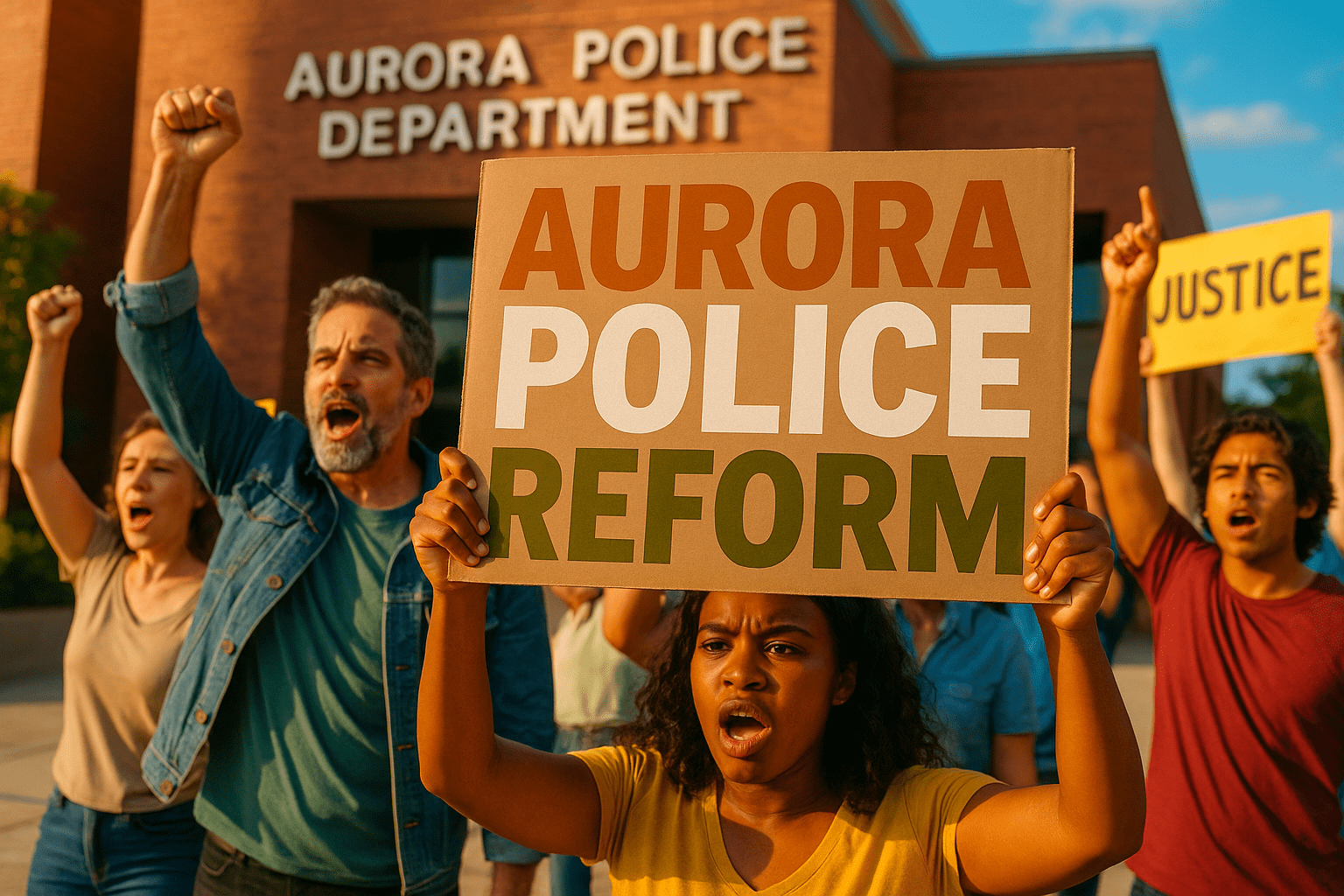

Aurora Police Reform: A Deep Dive
By Darius Spearman (africanelements)
Support African Elements at patreon.com/africanelements and hear recent news in a single playlist. Additionally, you can gain early access to ad-free video content.
Understanding the Consent Decree
The Aurora Police Department (APD) operates under a consent decree. This court-ordered agreement addresses systemic issues within the department (denvergazette.com). It is a legal mandate for public safety reform. The decree followed an investigation that found patterns of bias and excessive force (coloradopolitics.com). Aurora is the first Colorado city under state oversight for police reform (cpr.org).
The investigation by the attorney general’s office also uncovered unlawful ketamine use by the Fire Department (coloradopolitics.com). Consequently, the city agreed to implement changes across its public safety agencies (coloradopolitics.com). This decree aims to improve policies and training. It provides concrete guidance on decision-making and discretion in police interactions (auroragov.org).
What is a Consent Decree?
Consent Decree: A court-ordered agreement between parties, often used to address systemic issues within government agencies. In Aurora, it is a legal mandate for public safety reform following an investigation that found patterns of bias and excessive force. This decree aims to improve policies and training, providing concrete guidance on decision-making and discretion in police interactions.
Addressing Bias and Force
The consent decree specifically targets patterns of bias and excessive force within the APD (coloradopolitics.com). One key mandate, “Mandate 8,” focuses on addressing racial bias in policing (auroragov.org). This involves improving policies and training to combat bias effectively (auroragov.org). The goal is to provide clear guidance on decision-making and discretion during contacts, arrests, and uses of force (auroragov.org).
The department aims to align its operations with industry best practices (denvergazette.com). This includes strategies to combat bias and ensure fair treatment for all community members (auroragov.org). The consent decree is a living document. It guides the APD toward continuous improvement and accountability (denvergazette.com). The department's mission is to make Aurora a safe community for everyone (denvergazette.com).
The Independent Monitor's Role
IntegrAssure was appointed as the independent consent decree monitor in February 2022 (auroragov.org). Their primary role is to oversee Aurora's compliance with the decree (auroragov.org). The monitor provides technical assistance on new policies and training (auroragov.org). This ensures that mandates are met on schedule (auroragov.org).
Furthermore, the monitor communicates progress to the community through regular reports (auroragov.org). These reports include quarterly updates in the first year and semi-annual reports in the second year (auroragov.org). The monitor's findings can highlight areas needing improvement. For example, concerns were raised regarding the Aurora police shooting of Kilyn Lewis (cpr.org). This indicates areas where compliance or practices are under scrutiny (cpr.org).
Less Lethal Options and Accountability
“Less lethal options” refer to tools and tactics used to subdue individuals without deadly force. These options aim to minimize serious injury or death. Common examples include tasers, pepper spray, beanbag rounds, and physical restraints. De-escalation techniques are also crucial less lethal approaches. The independent consent decree monitor questioned why these options were not used in the Kilyn Lewis case (rcfp.org).
The monitor's report found critical issues in the confrontation between officers and Kilyn Lewis (rcfp.org). It explicitly stated that “less lethal options were not deployed” by the APD (rcfp.org). The report questioned whether a different approach could have been used (rcfp.org). This highlights the importance of considering alternatives to lethal force. It also underscores the monitor's role in scrutinizing police actions.
Internal vs. External Investigations
Internal investigations, like those by the APD, determine if an officer violated departmental policy. District attorney investigations focus on whether criminal charges are legally warranted. External oversight, such as that by the independent consent decree monitor, offers a broader review. This independent review assesses police practices and compliance with reform mandates. It often identifies systemic issues that internal reviews might miss (rcfp.org).
This distinction can lead to different conclusions regarding accountability. For instance, the officer who shot Kilyn Lewis was cleared by the local district attorney (rcfp.org). The APD's internal investigation also found no policy violation (denvergazette.com). However, the independent monitor raised critical questions about the incident (rcfp.org). This discrepancy underscores the need for independent oversight. It ensures a comprehensive evaluation of police conduct.
Transparency and Accountability Efforts
The consent decree itself is a major step toward transparency and accountability. The independent monitor regularly publishes reports on progress (auroragov.org). This public reporting promotes transparency. The decree also mandates improvements in policies and training (auroragov.org). These changes include addressing bias and providing clear guidance on decision-making (auroragov.org).
These policy and training changes are foundational to accountability. The ongoing oversight by the monitor ensures mandates are met on schedule (auroragov.org). The monitor's ability to raise concerns, as seen in the Kilyn Lewis case, indicates their role in enforcement (cpr.org). This continuous scrutiny helps uphold the principles of transparency and accountability. It aims to build trust within the community.
Progress and Challenges in Reform
The Aurora Police Department has seen an increase in officer reports of using force in 2023 (cpr.org). However, lethal use of force has dropped (cpr.org). While some bias training deadlines were missed, mandated reforms remain on track (cpr.org). The monitor's reports communicate overall progress. However, specific metrics or detailed examples of improvements are not always extensively provided.
The consent decree mandates improvements in policies and training for contacts, arrests, and uses of force (auroragov.org). The goal is to provide concrete guidance on decision-making and discretion (auroragov.org). This includes addressing bias and implementing strategies to combat it (auroragov.org). The overarching goal is to reform these critical areas of police work. This ensures a safer and more equitable community.
Aurora Police Force Reports in 2023
The Kilyn Lewis Case Controversy
Kilyn Lewis was shot by an Aurora police officer. Reports indicate he was unarmed, with his hands up, and surrendering (rcfp.org). This information comes from edited police body-worn camera footage (rcfp.org). Despite these details, a local district attorney concluded the officer was justified in using deadly force (rcfp.org). The district attorney declined to pursue charges (rcfp.org).
The Aurora Police Department’s internal investigation also found no policy violation by the officer (denvergazette.com). However, Lewis's family accused police of misconduct (rcfp.org). An independent consent decree monitor's report found critical issues with the confrontation (rcfp.org). The monitor specifically noted that “less lethal options were not deployed” (rcfp.org). They also questioned if a different approach could have been used (rcfp.org). This stark difference between internal findings and the monitor's concerns highlights the ongoing controversy surrounding the case.
Duration and Enforcement of the Decree
The provided information does not explicitly detail the timeline for the consent decree's conclusion or extension. However, the independent monitor, IntegrAssure, plays a crucial role in its enforcement (auroragov.org). IntegrAssure is responsible for ensuring mandates are met on schedule (auroragov.org). They also provide technical assistance to facilitate compliance (auroragov.org).
Compliance is enforced through this ongoing oversight and regular public reporting (auroragov.org). The monitor's ability to raise concerns about compliance, as seen in the Kilyn Lewis case, indicates their findings influence enforcement (cpr.org). This continuous scrutiny ensures the department remains accountable. It also drives ongoing reform efforts.
Media Scrutiny and Public Awareness
The Denver Post and Aurora Sentinel frequently report on the Aurora Police Department (denverpost.com). They cover various incidents, arrests, and ongoing news related to public safety (denverpost.com). The Denver Post maintains a dedicated tag for “Aurora Police Department” articles (denverpost.com). This ensures consistent coverage of the department's activities.
The Aurora Sentinel, also covered by The Denver Post, features news and opinion pieces about Aurora (denverpost.com). These include discussions about the police department (denverpost.com). Such media attention plays a vital role in public awareness. It also helps maintain pressure for continued reform and accountability. This transparency is crucial for community trust.
Key Media Outlets Covering Aurora Police
Broader Context of Police Reform
Other police departments across the nation are also implementing changes. These include creating review boards for use-of-force incidents (indystar.com). They also provide annual implicit bias training (indystar.com). These efforts aim to improve department culture and address racial sensitivity (indystar.com). The Aurora Police Department's efforts are part of this larger national movement toward police reform.
The challenges faced by the APD are not unique. Many communities grapple with issues of bias, use of force, and transparency in policing. The consent decree in Aurora represents a significant commitment to addressing these issues head-on. It aims to foster a police force that serves all members of the community equitably and with integrity.
ABOUT THE AUTHOR
Darius Spearman has been a professor of Black Studies at San Diego City College since 2007. He is the author of several books, including Between The Color Lines: A History of African Americans on the California Frontier Through 1890. You can visit Darius online at africanelements.org.
